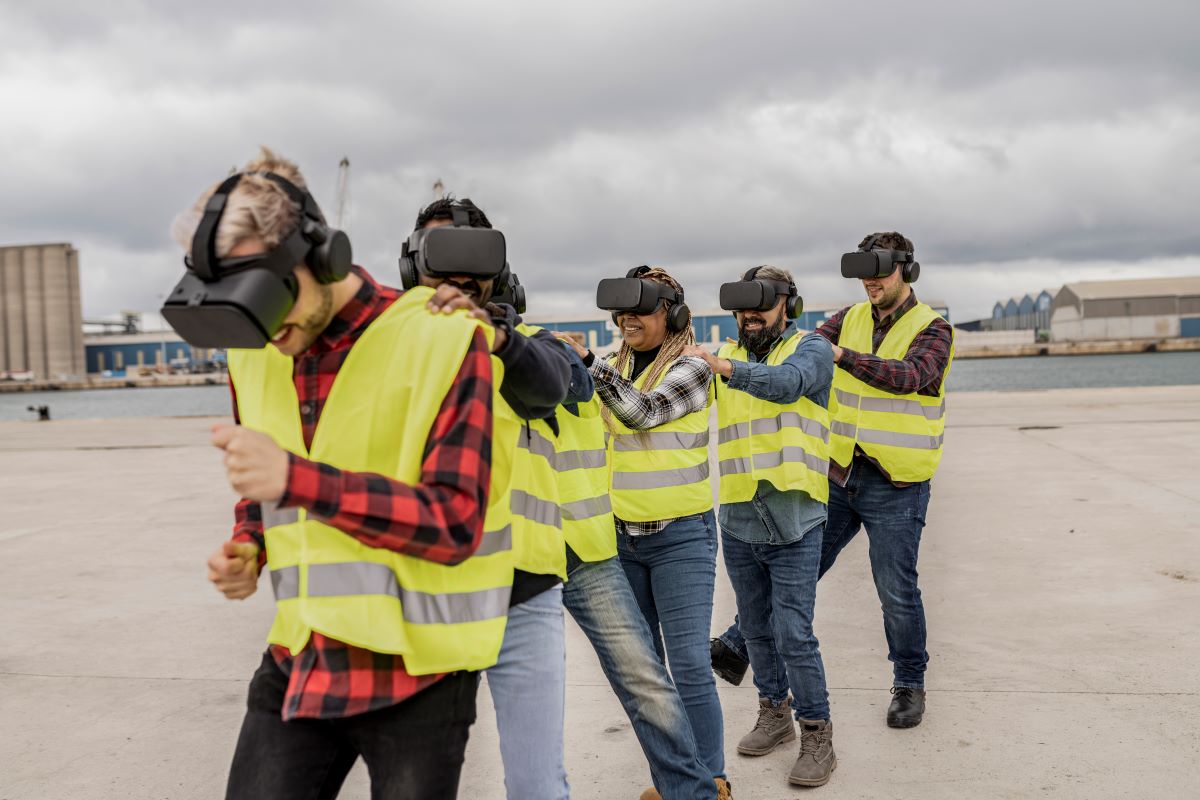
Merging Health and Safety Videos with Gamification
Workplace safety is a fundamental priority for companies across all industries. Whether in construction, healthcare, or corporate offices, organisations are constantly seeking innovative ways to ensure employees are trained effectively in safety protocols. Traditional safety training methods, while necessary, often lack the engagement and impact needed to ensure long-term retention and behavioral change. One emerging solution to this challenge is gamification—an approach that applies game-like elements to training and education to enhance engagement, learning, and recall. Health and safety videos complement gamified training by providing visual demonstrations of safety principles, which then serve as the foundation for the interactive, game-like elements that reinforce learning. This article will explore how gamification is being integrated into safety training programmes and how health and safety videos work alongside these methods to improve training effectiveness.
What is Gamification in Safety Training?
At its core, gamification involves applying game design principles to non-game contexts to motivate and engage participants. In the context of safety training, it transforms otherwise routine and sometimes tedious safety protocols into interactive, fun, and engaging experiences. Gamification is not about turning safety training into a full-fledged game, but rather incorporating elements such as challenges, rewards, progress tracking, and healthy competition into the training process to make it more engaging and memorable.
The goal of gamification in safety training is not just to make training more enjoyable, but also to improve learning outcomes by encouraging active participation and reinforcing desired behaviours. By embedding safety principles into game-like environments, employees are more likely to remember the key points and apply them in real-world situations.
Key Elements of Gamification in Safety Training
There are several fundamental components that make gamification effective in safety training. These elements are designed to promote learning, and encourage behavioural change.
Game Mechanics
One of the most basic and effective aspects of gamification is the use of game mechanics such as points, badges, and leaderboards. These elements are familiar to most people because they are commonly found in video games. In safety training, employees can earn points or badges for completing specific training modules or for demonstrating safe behaviours. Integrating health and safety videos into the point or badge system allows employees to earn rewards by accurately answering questions related to video content. Leaderboards can introduce a friendly level of competition among employees, motivating them to engage more thoroughly with the training content.
Interactive Content
To keep employees engaged, safety training must go beyond static presentations or passive learning. Gamified training typically involves interactive content such as quizzes, puzzles, and simulations. Health and safety videos can be an effective starting point for these gamified experiences, providing real-world scenarios that employees can watch and then engage with through interactive features. For example, after viewing a safety video, employees can answer quiz questions, identify hazards, or make decisions based on the scenarios presented. This interactive approach ensures that employees do not simply memorise safety rules, but also apply them in realistic settings.
Challenges and Rewards
Gamification thrives on the idea of progress and rewards. Employees face challenges or missions that they must complete in order to advance to the next level. Health and safety videos depicting realistic safety challenges can be integrated into this framework, where employees solve issues presented in the video to earn rewards. This can include actions like answering questions correctly, solving problems, or demonstrating specific safety practices in a virtual setting. The reward system offers instant gratification, such as unlocking new levels or earning badges, reinforcing positive behaviours and motivating further learning.
Gamified Safety Training in Action
Many companies have already begun implementing gamification into their safety training programmes with promising results. For example, in the construction industry, companies such as Laing O’Rourke and Richard Crookes have adopted gamified safety training platforms to engage their workers in more effective safety protocols. These programmes often combine interactive simulations with real-time feedback to help employees practice responses to various safety scenarios without the risks of being on-site. To complement these platforms, many companies use health and safety videos to set the stage for gamified modules, creating immersive scenarios that employees can interact with during training.
In practice, gamification can be applied to various aspects of safety training. In an office setting, for instance, employees might participate in a virtual fire drill game, where they navigate through a simulated building to reach the safest exit. In manufacturing, workers could be challenged to identify potential hazards in a production line scenario. This immersive and hands-on approach helps employees understand not just the what of safety protocols but the why and how behind them.
The Technology Behind Gamified Training
Gamified safety training has benefited significantly from advancements in technology. Virtual Reality (VR) and Augmented Reality (AR) are becoming increasingly common tools in gamified training. VR allows employees to engage in simulated environments where they can experience and react to safety challenges in a controlled, risk-free space. This immersive experience is often more effective than traditional methods, as it encourages employees to practice critical thinking and decision-making in high-stakes situations.
Furthermore, mobile apps and specialised software are helping to streamline gamified training experiences. These platforms track employees’ progress, provide feedback, and offer personalised learning experiences based on the individual’s pace and performance. Employees can engage in training at their convenience, making it easier to integrate safety learning into daily routines.
Psychological Benefits of Gamification
The appeal of gamification goes beyond fun and entertainment. It taps into human psychology to improve motivation, engagement, and recall. Game elements such as rewards, progression, and achievement appeal to intrinsic and extrinsic motivators. Employees are more likely to stay engaged with safety training when they receive immediate feedback and see their progress. This can make employees feel a sense of accomplishment and reinforce their commitment to learning safe practices.
Additionally, gamified safety training encourages positive behaviour reinforcement. As employees earn rewards for demonstrating safety knowledge or completing tasks, they are more likely to internalise these behaviours and carry them out on the job. Health and safety videos, when combined with gamification, appeal to visual learners and enhance retention through vivid, real-world scenarios. By providing realistic, interactive content, these videos make it easier for employees to apply their learning in real-world situations. Over time, this can lead to a culture of safety where employees are more conscious of their actions and make safety a priority in their work.
Challenges and Considerations
While gamification offers many benefits, it is not without its challenges. One major obstacle is the resistance some employees may have to new methods of training. Older employees or those unfamiliar with technology may find gamified training intimidating or unnecessary. Companies must ensure that their gamified training programmes are accessible to all employees and offer support for those who may need it.
Moreover, the success of gamified safety training depends on its design. Poorly designed programmes that focus too heavily on rewards or competition, rather than on teaching safety protocols, can lead to disengagement or a lack of focus. It is essential that gamified training programmes strike the right balance between entertainment and educational value.
The Future of Gamified Safety Training
The future of gamified safety training looks promising. The integration of artificial intelligence (AI) and the metaverse could further enhance the immersive experiences offered by VR and AR. AI-powered platforms could adapt training programmes to an employee’s learning style, providing customised experiences that help reinforce safety concepts more effectively.
Gamification also has the potential to expand beyond traditional industries such as construction and manufacturing. With the increasing adoption of gamified learning techniques, sectors like healthcare, retail, and even education could benefit from this approach, improving safety and training across a broader range of industries.
Final Thoughts
Health and safety videos are a practical addition to gamified training, helping to visually illustrate safety practices and hazard identification in a way that enhances the interactive experience. While gamification adds motivation through points, challenges, and competition, health and safety videos provide realistic scenarios that employees can watch and learn from before applying their knowledge through gamified tasks. This combination ensures that employees engage with abstract game elements and understand the real-world application of safety procedures.
Videos can show employees exactly how to handle specific safety situations, such as responding to a fire alarm or identifying faulty equipment. Once employees have viewed these videos, they can then interact with gamified elements—like quizzes or decision-making challenges—based on the scenarios shown. This method reinforces learning by connecting visual examples with practical tasks, making it more likely employees will remember and act on the safety procedures when they encounter them in real-life situations.
To ensure an effective training process, it is important to work with a video production company that understands and specialises in both gamification and health and safety training. These companies can create videos that are informative and designed to work with the interactive elements of a gamified programme, providing a cohesive, engaging training experience. By integrating video and gamification, organisations can create a more comprehensive and effective safety programme that keeps employees engaged while improving their knowledge and behaviour in real-world safety situations.
Take your safety training to the next level with Sound Idea Digital’s health and safety videos and gamified solutions. Contact us to get started.
We are a full-service Web Development and Content Production Agency in Gauteng specialising in Video Production, Animation, eLearning Content Development, Learning Management Systems, and Content Production.
Contact us for a quote. | enquiries@soundidea.co.za | https://www.soundideavideoproduction.co.za| +27 82 491 5824 |

